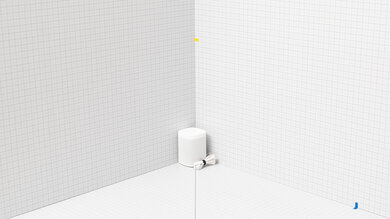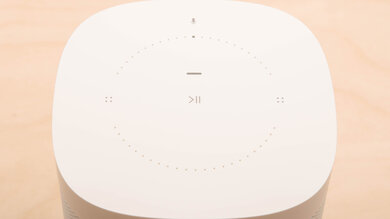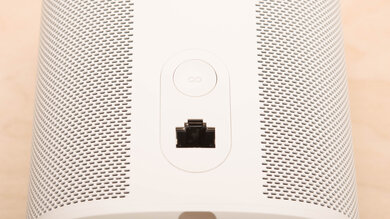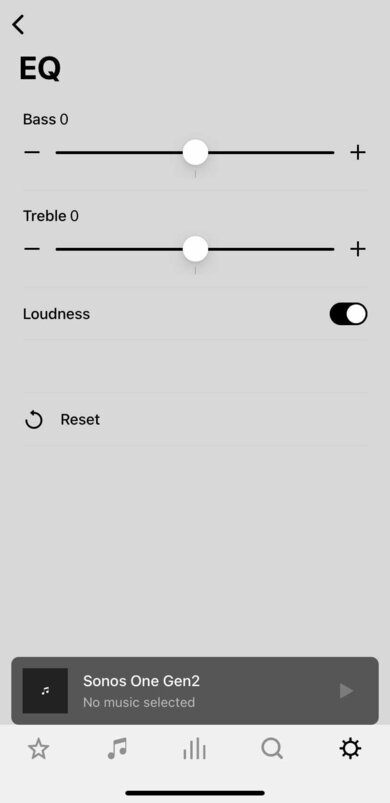The Sonos One Gen 2/One SL is the second generation of the Sonos One. It's a wired speaker with a sleek design that's easy to integrate into your existing home decor, and it's a great addition to your existing Sonos ecosystem. You can use it on its own or as a surround speaker with Sonos soundbars like the Sonos Arc. Built-in Alexa and Google Assistant support allow for hands-free control unless you purchase the SL variant, which comes without a microphone.
Our Verdict
The Sonos One SL is alright for music. Like other premium speakers on the market, you can adjust its output based on your room's unique acoustics using its Trueplay room correction feature. It's only available on iOS devices, but Android users can still use the Sonos S2 app to adjust the speaker's bass and treble to get the best possible sound. Voices and lead instruments are clear and detailed in the mix, and as a result, this speaker is suitable for listening to many different music genres.
- Bass and treble sliders via companion app.
- Decent directivity.
- Not loud enough for larger and more open spaces.
- Downmixes stereo content into mono.
The Sonos One SL is compatible with many other Sonos devices, including some of their most popular soundbars. That said, on its own, it doesn't give the most cinematic experience, but this is typical for a small standalone speaker. Thanks to its low latency over Apple AirPlay, you don't notice any lip-synching issues with your favorite videos. Dialogue is clearly reproduced, too, and there's a touch of rumble in the bass for action-heavy scenes.
- Bass and treble sliders via companion app.
- Can be connected to Sonos soundbars as surround speakers.
- Not loud enough for larger and more open spaces.
- Downmixes stereo content into mono.
- No audio streaming via Bluetooth.
The Sonos One Gen 2 is fair for podcasts. Dialogue is clear and detailed in the mix right from the jump, meaning you can easily follow along with your favorite shows. The speaker gets loud enough to fill an average-sized living room with sound, and if you own other Sonos devices, you can connect them to this speaker to spread your show throughout different rooms of your home. However, given its wired design, you can't take the speaker with you around the house, which isn't the most convenient.
- Decent directivity.
- Not loud enough for larger and more open spaces.
The Sonos One Gen 2 has good voice assistant support. It has both Alexa and Google Assistant built-in, meaning you can activate them hands-free with only your voice. The speaker hears your commands clearly, even if you're far away, so you can easily add ingredients to your grocery list, check the weather, and perform other daily functions. That said, it does have difficulty picking up your voice in noisier settings, like parties. Of course, this feature isn't available if you buy the SL variant since this version lacks a microphone.
- Supports Alexa and Google Assistant.
- Decent directivity.
- Not loud enough for larger and more open spaces.
The Sonos One Gen 2 is a wired-only speaker that isn't designed for outdoor use.
Changelog
- Updated Feb 26, 2024: We've merged the Sonos One Gen 2 review with the Sonos One SL since they're variants on the same speaker. The SL version comes without a microphone, so we've updated the text in the Controls and Voice Assistant boxes accordingly. Usage scores haven't changed, but we've refreshed the text to elaborate on these variants' differences.
- Updated Apr 18, 2023: Added market comparison for the Sonos Era 300 in the Soundstage box.
- Updated Jan 19, 2023: Minor updates to the text for clarity and consistency. No changes in test results.
- Updated Oct 21, 2022: Added a comparison to the IKEA SYMFONISK Picture frame in the 'Style' box.
Check Price
Differences Between Sizes And Variants
The speaker comes in two color variants: 'Black' and 'White'. We tested the White variant, and you can see its label here. However, we expect the Black variant to perform similarly to our model. We also tested the second generation of this speaker. Sonos advertises that the difference between this generation and the previous one is that they've increased the memory, added Bluetooth Low Energy for first-time pairing with the speaker, and added a more powerful and updated processor. That said, no features have changed.
The Sonos One SL is the same speaker without a microphone, so it lacks voice assistant support. You can still use the Trueplay turning feature with this variant.
If you encounter another variant, please let us know in the forums, and we'll update our review.
Popular Speaker Comparisons
The Sonos One Gen 2 is the second generation of the Sonos One. Unlike the Sonos Move or Sonos Five, you can add it to an existing Sonos soundbar setup if you want surround speakers, or you can use it on its own. While it has a boomy sound profile, you can adjust it using its companion app's bass and treble sliders. You can also only use this speaker wired; while you can't stream audio to it using Bluetooth, it has an Ethernet port, meaning you can connect it to your home network. You can opt for the SL variant if you aren't interested in voice assistant support.
Check out our recommendations for the best portable Bluetooth speakers, the best smart speakers, and the best Sonos speakers.
The Sonos Era 100 is better than the Sonos One Gen 2/One SL. While they're both premium speakers designed for home use, the Era 100 has slightly better sound quality. The bass doesn't leak into the mids quite as much, resulting in a cleaner sound. But both speakers have a healthy boost in the high-bass region, adding warmth to basslines. Plus, unlike the One Gen 2, the Era 100 can playback stereo content without downmixing it into mono. Additional features are available, including Bluetooth connectivity and a Quick Tuning feature for Android users.
The Sonos Era 300 is better than the Sonos One Gen 2/One SL. The Era 300 is a newer release that offers more premium features, including Bluetooth connectivity and Dolby Atmos capabilities. It's especially handy for those who want to listen to compatible Dolby Atmos Music or even pair up the speaker with a compatible soundbar to watch Dolby Atmos content. It's a stereo speaker, unlike the One Gen 2, which downmixes stereo content into mono to play it. Plus, the Era 300 gets louder.
The Sonos One Gen 2/One SL is a slightly better speaker than the IKEA SYMFONISK Bookshelf, though they are similar speakers. The Sonos offers very good voice assistant support with Alexa and Google Assistant built-in as long as you don't purchase the SL variant. It also has a somewhat better-balanced sound profile than that of the IKEA. That said, the IKEA can get slightly louder with fewer compression artifacts at max volume, so your audio remains clean when listening at louder volumes.
The Sonos Move is a better speaker than the Sonos One Gen 2/One SL overall. The Move is battery-powered and has a handle built into it, making it more portable. It's rated IP56 for dust and water resistance, so you can take it outdoors without needing to worry about it getting a bit wet. It can produce a more extended low bass than the One Gen 2 and can get louder.
Test Results

The Sonos One SL is a smaller-sized speaker. It's meant to sit vertically on your table and comes in two different colors: 'Black' and 'White.' You can also pair this speaker with the Sonos Playbar, Sonos Playbase, or Sonos Beam if you're looking to upgrade your soundbar setup with surround speakers. If you're looking for a speaker built in collaboration with Sonos that can blend in better with most home decor, check out the IKEA SYMFONISK Bookshelf speaker, the IKEA SYMFONISK Speaker lamp, and the IKEA SYMFONISK Picture frame speakers.
This speaker isn't very portable. You can hold it in one hand since it isn't very large or heavy. Due to its wired design, it needs to remain wired to an outlet for it to work, making it difficult to bring it outside with you.
This speaker has an alright build quality. Its top and bottom side are made of plastic, while a metal grille covers most of the speaker's front-facing sides, which makes it feel sturdy. Like the Sonos Five, it's advertised to withstand high-humidity environments like a bathroom with a running shower. However, it doesn't have an IP rating for dust and water resistance, so it's best to avoid placing it near water sources, like near your kitchen sink or in your bathroom.
The controls are on the top side of the speaker. You can swipe left or right to return to the previous song to skip to the next one. You can press and hold the play/pause button to add music that's playing in another room or to group speakers together. There's also a 'Join' button to reset the speaker or connect it to a Sonos system. You can turn the status light on the top on and off through the companion app. Of course, you won't find a microphone mute button on the Sonos One SL variant since there isn't a microphone on hand to mute in the first place.
Like other Sonos speakers on the market, this device has a built-in room correction tool that automatically optimizes its audio reproduction based on the unique acoustics of your living room. The room correction tool, which is called Trueplay, is only available on iOS devices. However, Android users can adjust the speaker's bass and treble to accommodate for their room's acoustics manually. With it on, the speaker's frequency response is quite similar to the original Sonos One. Voices and lead instruments are clear and detailed in the mix, making it suitable for listening to lots of different types of audio content. Plus, there's a little extra boom in the high-bass, which adds excitement to bass-centric genres like EDM and hip-hop.
This speaker's soundstage performance is disappointing. While you can pair it to another compatible speaker to create a stereo pair, it downmixes stereo content to mono when using it on its own, which isn't as immersive. Its directivity is decent, meaning you can hear your audio clearly from most angles. If you're looking for a speaker with even better directivity, check out the JBL Pulse 4, or you can check out the Sonos Era 300, which is a stereo speaker.
This speaker gets loud enough to fill an average-sized living room with sound. It struggles to fill larger and more open spaces, like basements. Also, at max volume, there are some pumping and compression artifacts present that affect the clarity of audio reproduction.
This speaker has Alexa and Google Assistant built-in and can easily register your commands from far away, though it struggles to do so in noisier rooms. You can mute the speaker's mic when you no longer want your assistant listening to you, which is nice. If you're looking for an Alexa and Google Assistant-enabled speaker that has an easier time understanding your commands in noisier rooms, check out the Bose Portable Smart Speaker. Also, if you'd prefer the privacy of a speaker without voice assistant support, you can check out the Sonos One SL variant instead.
The Sonos S2 app is outstanding and is supported on iOS and Android. It offers bass and treble sliders but lacks a more comprehensive EQ. That said, the app allows you to connect it to another unit to create a stereo pair or link multiple speakers to cover a wider area together for a party. You can also connect multiple units in different rooms of your home, meaning you can play different audio content in different rooms of your home at the same time.
This speaker has an Ethernet port to connect it to your home network. That said, there's no AUX port you can use to wire older devices to the speaker.
This speaker uses Bluetooth Low Energy so that you can temporarily communicate with your phone or other mobile devices to simplify the first-time setup process. However, you can't use this connection to stream audio.
This speaker is Wi-Fi compatible. It has very low latency via Apple AirPlay, meaning you can stream video without noticeable audio sync issues. Some apps compensate for latency differently, and your real-world experience may differ. Unfortunately, it doesn't support Chromecast.







